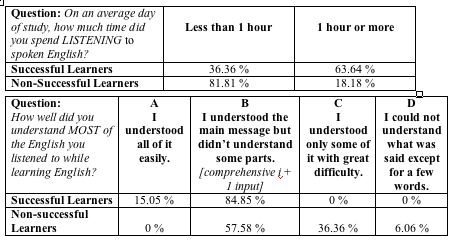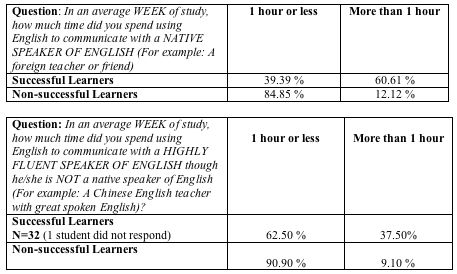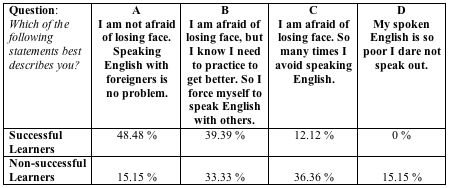Helping EFL Students Improve Their Spoken English
Francis J. NoonanEaston Area School District (Easton, PA, USA)
chipperchina[at]hotmail.com
Introduction
Almost every college student in China seems to be studying English. I see them listening to radio programs on their dormitory bed, studying the dictionary in the back of the classroom, and completing grammar exercises in the cafeteria. Still, these same students come to me and ask the same question: “Teacher, my spoken English is very poor. How can I improve my spoken English?”I was never quite satisfied with the answers I gave out to this reoccurring question. I wondered. What exists in SLA literature about this? What are real EFL learners doing that works? What makes some students successful language learners and others not?
Preparing an Answer
The last few years I have studied second language acquisition theory with these questions in mind. Also, I recently surveyed 33 successful and 33 non-successful Chinese EFL students about their attitudes and practices concerning their English study. Successful students I define as those who are able to “converse in a clearly participatory fashion; initiate, sustain, and bring closure to a wide variety of communicative tasks; narrate and describe with paragraph-length connected discourse . . . [and] understand main ideas and most details of connected discourse on a variety of topics beyond the immediacy of the situation” (Hadley, 1993). Non-successful learners I define as those described by themselves and others as unable to use English to communicate effectively.Therefore, with a foundation on modern theory and data from the real world of language learning, I offer these suggestions for struggling Chinese EFL students. Then again, sometimes the best way to teach is to answer questions with questions. So now, when I am asked “How can I improve my spoken English?” I respond with the following questions.
Why Do You Want to Learn English?
Motivation. The reason why we study. Though researchers describe numerous subtleties, two types of motivation reoccur throughout the literature: instrumental and integrative motivation. Instrumental motivation is one in which the learner desires to use the language as a tool to achieve some desirable ends. In contrast, an integrative motivation is one in which “learners may choose to learn a particular L2 because they are interested in the people and culture represented by the target-language group” (Ellis, 1997, p75). In various contexts, both motivations have proved important. Of course, students can have both types of motivation at the same time.Many students in China have a weak-instrumental motivation for studying English. They just want to pass the CET-4 so they can get their bachelor’s degree. Others have a strong-instrumental motivation. They study because they want to acquire a good job or study abroad. Some study English for integrative reasons. They simply enjoy it and want to make new friends. My survey produced the following results:

Debate surrounds the question of whether success is the result of one’s motivation or one’s motivation is the result of success. Nevertheless, these results are suggestive. Students who study only for the sake of passing a test are highly unlikely to be successful. Strong instrumental motivations are better. In this study, however, it appears that students with an integrative motivation are most likely to be successful.
As one student responded, “If you learn English but can not speak it fluently, you are like a blind being on the street. You [will] lose many precious opportunities to enjoy the beauty of this world. You are kept inside a dark box. But if you speak [English] well, you will learn about culture, people and life. You feel your life colourful and meaningful. You are not isolated.”
Our job as teachers is not to simply teach students language but to show them that learning a language is a means to a friend, a door through which they can enter a new world.
What Are You Listening To?
Stephen Krashen (1985) proposed the Input Hypothesis. The Input Hypothesis claims that learners make progress in English acquisition through exposure to comprehensible input. Comprehensible input is defined as “understanding input that contains structures at our next ‘stage’ – structures that are a bit beyond our current level of competence” (Krashen, 1985, p2). This is often designated with the equation “i + 1”. The “i” represents the learner’s current competence in the second language; the “+ 1” symbolizes the features of the input that are beyond the learner’s competence, and which he is developmentally ready to acquire. Accordingly, input that is either too simple or complex will not help a learner make progress in spoken English. To explore this, I asked the following questions with the following results:
The results are clear. The majority of successful English language learners in this study 1) listen to English for 1 hour or more and 2) listen to the right kind of input, input where they can understand the main idea but not some parts. There are many aspects of the full Input Hypothesis that are seriously questionable. Nevertheless, I believe it is safe to claim that exposure to comprehensible input greatly benefits the language learner.
Therefore, we as teachers ought to encourage our students to listen to English both in and outside of class. If students’ sources of input are too difficult for them to comprehend, we can help them develop strategies (i.e. repetition, shorten length) to make it comprehensible or find different, simpler sources of input.
Whom Do You Speak With?
Many scholars believe that interaction, the act of communicating with another person, plays a significant part in second language learning. Michael Long believes comprehensible input is of great value but believes it is best received through interaction. This is because when a fluent speaker and a less fluent speaker interact, they enter into a negotiation of meaning. As they use the situational context, repetitions, and clarifications to maximize comprehension, the more likely the learner will receive input just beyond his present competency, the i + 1 input (Ellis 1997, 47; Mitchell 1998, 128-129).While Long focuses on the value of the input gained through interaction, Merrill Swain (Ellis 1997) points out several benefits of learner output (speaking) in interaction. First, with comprehensible input, meaning can often be attained without paying attention to the grammar of the input. She maintains output can help students notice a gap between what they say and what they hear; thereby raising their consciousness that some of their grammar is not correct. Second, output provides learners with incentive to formulate and opportunities to test hypotheses about language. They can apply a rule to an utterance to see if it leads to successful communication or elicits negative feedback. Finally, learners often reflect on their own output, discussing problems and potential solutions. For various reasons, many scholars agree interaction is an important part of language learning. Once more, I investigated the importance of interaction through my survey.

Clearly, one’s odds of acquiring English increase with opportunities to use English to communicate with others. The good news is that almost every student in China already knows that communicating with a native English speaker will help them acquire English. The bad news is that 85 – 90 % of non-successful students are not using English to communicate with anyone. Obviously, there are not enough native speakers in China for everyone to speak with. But is this the only reason students refrain from interaction? I found that “saving face”, not wanting to embarrass oneself by making mistakes, also prevents many students from speaking.

Unfortunately, 51.52% of non-successful learners are avoiding interaction due to fear of losing face. Also, for some reason both successful and non-successful learners are reluctant to speak with fluent non-native speakers.
Consequently, we as teachers can help our students to interact more by creating a safe environment, encouraging them to take risks, and persuading them to communicate with proficient non-native speakers.
How Do You Study Grammar?
Since Stephen Krashen (1981) declared that learning could not become acquisition, explicit grammar instruction has been neglected by many in the West. Recently, scholars such as Rod Ellis have pioneered the counter position that explicit grammatical instruction is not only useful for developing metalinguistic knowledge, but also for aiding acquisition through “noticing” (Ellis, 2002). Noticing is basically the idea that if learners pay attention to both the form and meaning of certain language structures in input, this will contribute to the internalization of the grammatical rule (Batstone, 1996).Although unable to test this idea of noticing directly, I wondered if there was a difference between successful and non-successful students in the amount of time they spent studying grammar.

Apparently, most successful learners claim to spend more time each day listening to English than studying grammar. Therefore, a reasonable inference is that the majority of successful language learners in this study use grammar in a subordinate role; their primary focus is on communication, using English as a tool to receive and send messages.
Accordingly, if the goal is to improve one’s spoken English, we may advise our students to study grammar but not to let the memorization of grammatical rules and such activities dominate one’s English study. Rather, encourage listening and using the target language to be the focus of one’s study. Advise them to study grammar for the following reasons: 1) to make input comprehensible and 2) to develop awareness to help the learner notice the form of input and their own output. This may help them eventually internalize these grammatical rules rather than storing them up in their short-term memories where they will be quickly forgotten.
Conclusion
In conclusion, I confess my knowledge of SLA theory is incomplete and the scope of my study is limited. I am offering no magic formula for language learning. Nevertheless, I suggest many students will improve their English skills if they do the following:- Move beyond a motivation that simply desires to pass a test to one that views language as a key to unlock opportunities.
- Listen to comprehensible input on a daily basis.
- Overcome fear of losing face. Find and take advantage of opportunities to use English to communicate with both native and proficient non-native speakers.
- Study grammar in a way that supports the purpose of language, communication, not as an end in itself.
Note
The data in this article is based on an unpublished study I conducted as part of my graduate work for the University of Turabo in the summer of 2004. Through friends and colleagues, students and recent graduates were surveyed from various schools and locations in China. All participants learned English in China, not abroad. The survey instrument was a 10 question multiple-choice survey with a few open-ended questions. The survey was orally translated to non-successful participants as necessary by the survey administrator. If you would like more information, please e-mail me and I would be happy to send you a copy of the study.References
- Batstone, Rob. (1996). Key Concepts in ELT: Noticing. ELT Journal, Volume 50/3, 8 paragraphs. Available: http://www3.oup.co.uk/eltj/hdb/Volume_50/Issue_03/freepdf/500273.pdf
- Brown, James Dean. (2001). Using Surveys in Language Programs. UK: Cambridge University Press.
- Ellis, Rod. (2002). The Place of Grammar Instruction in the Second/Foreign Language Curriculum. In Fotos, Sandra and Eli Hinkel (Eds.), New Perspectives on Grammar Teaching in Second Language Classrooms (pp. 17-34). Mahwah, NJ: Lawrence Erlbaum Associates, Inc.
- Ellis, Rod. (1997). Second Language Acquisition. New York: Oxford University Press.
- Hadley, Alice Omaggio. (1993). Teaching Language in Context. USA: Heinle & Heinle Publishers.
- Krashen, Stephen. (2002). “The Comprehension Hypothesis and Its Rivals.” Selected papers from the International Symposium on English Language Teaching/Fourth Pan-Asian Conference. Taipei: Crane Publishing Company. Available: http://www.azusausd.k12.ca.us/bilingual/pdf%5CKrashen89.pdf
- Krashen, Stephen. (1985). The Input Hypothesis: Issues and Implications. New York: Longman Press.
- Krashen, Stephen. (1981). Second Language Acquisition and Second Language Learning. Pergamon Press. Also available on-line: http://www.sdkrashen.com/SL_Acquisition_and_Learning/index.html
- Mitchell, Rosamond and Florence Myles. (1998). Second Language Learning Theories. Great Britain: Oxford University Press.
The Internet TESL Journal, Vol. XI, No. 7, July 2005
http://iteslj.org/
http://iteslj.org/Articles/Noonan-Spoken/